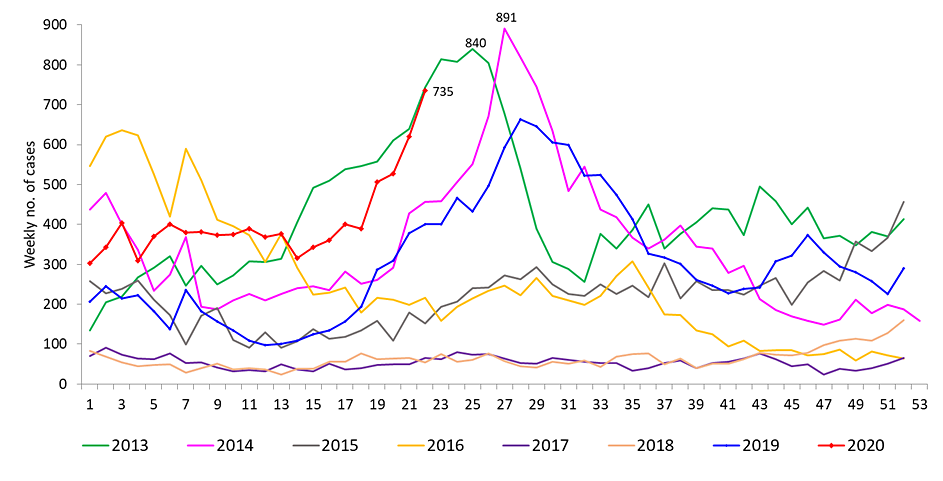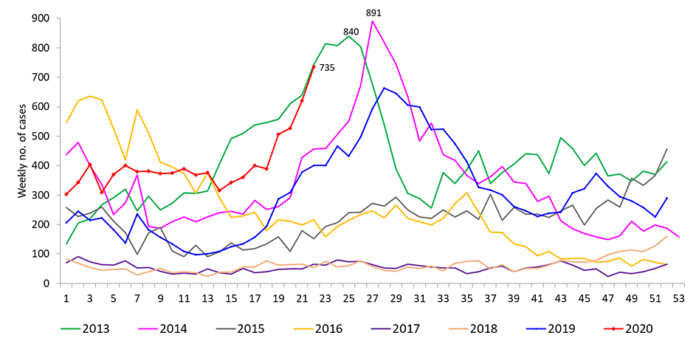SINGAPORE: The number of dengue cases this year could surpass 2013’s figure of 22,170, unless urgent action community action is taken, the National Environment Agency (NEA) warned on Wednesday (Jun 3).
As of Tuesday, there have been 9,261 reported dengue cases this year, the highest in the same period since 2013, which saw the largest outbreak in Singapore’s recent history, said the agency.
As it stands, the number of weekly dengue cases is expected to exceed the historical high of 891.
There were 735 dengue cases last week, up from the 300 to 400 weekly cases from January to April.
“Singapore has not seen such a high weekly number of dengue cases since the peak years in 2013 and 2014,” said NEA.
“The number of dengue cases this year is expected to exceed the 15,998 cases reported in 2019, and may even surpass the 22,170 cases reported in 2013.”

Annual trend of dengue cases from 2013 to 2020. (Infographic: National Environment Agency)
Twelve people, between the ages of 56 and 80, have died as a result of dengue so far this year. Ten of the 12 had worked or lived in active dengue cluster areas.
“Urgent collective community effort is needed to drastically reduce mosquito breeding habitats and slow down the rise in the number of dengue cases,” said NEA.
COVID-19 A FACTOR BEHIND INCREASE
The agency said the spike in dengue cases can be attributed to several factors, one of which is the increase in Dengue virus serotype 3 (DENV-3) since the beginning of this year.
DENV-3 is a less common strain of dengue that was last seen in a dominant position in Singapore about 30 years ago, meaning there is low immunity in the population and rapid disease transmission.
READ: Wolbachia mosquito field test ‘successful’, project expanded to dengue high-risk areas in Choa Chu Kang, Bukit Batok
Singapore is also entering the traditional dengue peak season, when warmer weather facilitates the faster multiplication of the Aedes mosquito and the dengue virus, increasing the chances of dengue transmission. NEA said it has detected more areas with high Aedes mosquito populations.
The COVID-19 outbreak in Singapore and the resulting “circuit breaker” has also exacerbated the dengue situation, said NEA, with the dengue spike in early May coinciding with the circuit breaker measures.
The Aedes mosquito, the main vector of dengue, mainly dwells in indoor spaces and usually bites during the day.
“With a shift in human concentration from offices to homes, more people staying at home during the day also means more blood meals for the female Aedes aegypti mosquitoes, especially in residential areas where the mosquito population is also high,” said NEA.
“Together with the availability of breeding habitats for the mosquitoes, this produced even more mosquitoes. This has likely exacerbated the situation, leading to the sharp rise in the number of dengue infections in the past four weeks.”
From January to May, NEA conducted about 341,000 inspections for mosquito breeding across Singapore and uncovered about 7,800 breeding habitats.
NEA dengue inspection officer checking for mosquito breeding at the roof top of residential premises. (Photo: National Environment Agency)
NEA said it has observed a five-fold increase of Aedes mosquito larva detected in homes and common corridors in residential areas during the two-month circuit breaker period compared to the two months prior.
The agency urged homeowners to cooperate with NEA officers in allowing them home access to facilitate checks and indoor misting.
READ: Mosquitoes found breeding in ‘hidden’ containers placed in trees, says Hougang MP Png Eng Huat amid dengue concern
“As we continue to manage the COVID-19 situation, we need to be mindful that dengue is another serious public health threat that Singapore faces,” said NEA director-general of public health Chew Ming Fai.
“During our inspections, we continue to find mosquito breeding in common habitats, such as flower pot plates and domestic containers. Lack of care or diligence in maintaining one’s premises or home could easily lead to mosquito breeding, putting the whole community at risk.”
CONSTRUCTION SITES INSPECTED
NEA has continued to step up preventive surveillance of construction sites, which have been closed during the circuit breaker period.
Before the start of the circuit breaker, construction site operators were instructed to maintain a minimum workforce to perform housekeeping and facilitate pest control services within the sites.
NEA dengue inspection officer checking for mosquito breeding at a construction site after a rainy day. (Photo: National Environment Agency)
Despite this, NEA observed a two-fold increase in Aedes mosquito larvae at construction sites during the circuit breaker period. So far, 82 per cent of construction sites have been inspected since the start of the circuit breaker, it said.
From January to May, 52 summonses and two stop work orders were issued to construction sites.
Two contractors will also be charged in court for repeat offences, the agency added.
“NEA will continue with our inspection and enforcement efforts, and we will not hesitate to take action against anyone found to have created conditions favourable for the propagation or harbouring of vectors,” said Mr Chew.
“All of us must do our part in our collective fight against dengue.”
Information on the dengue situation can be found on the NEA website, the Stop Dengue Now Facebook page and the myENV app.





